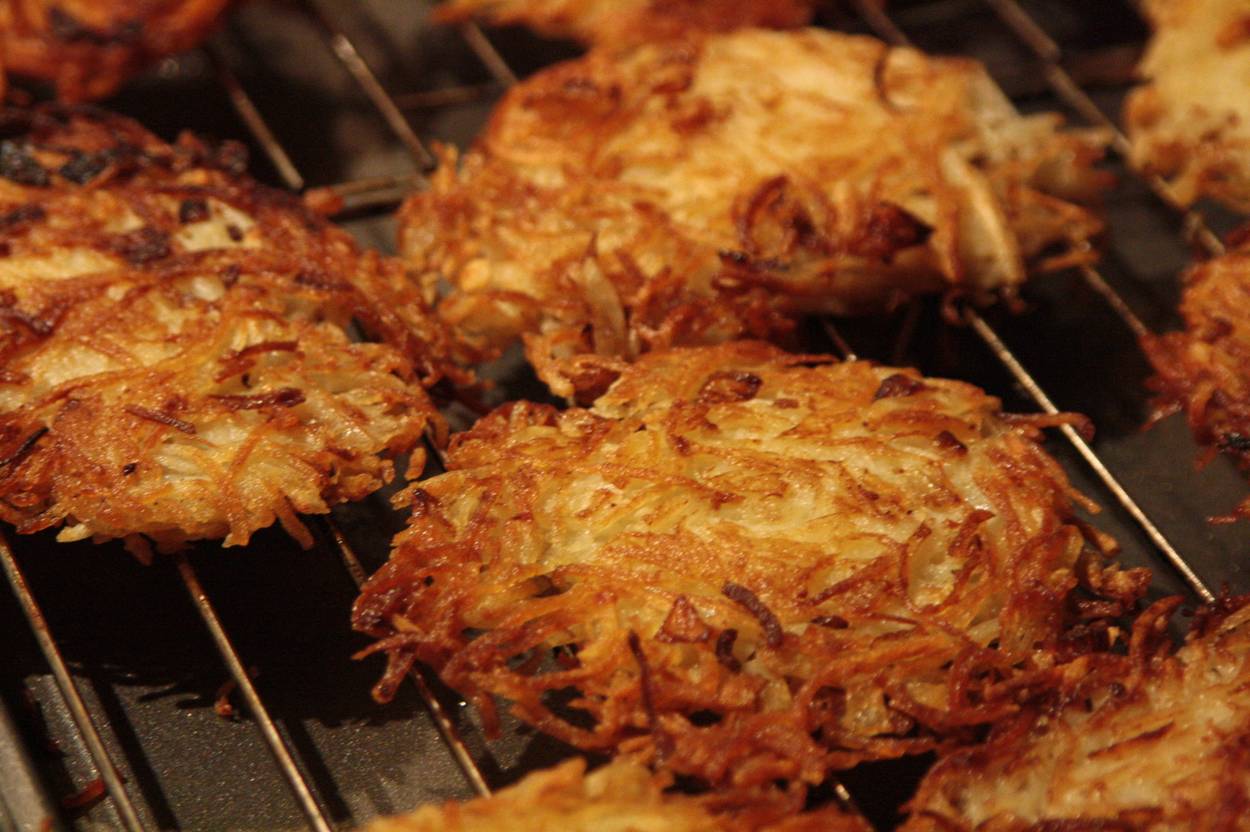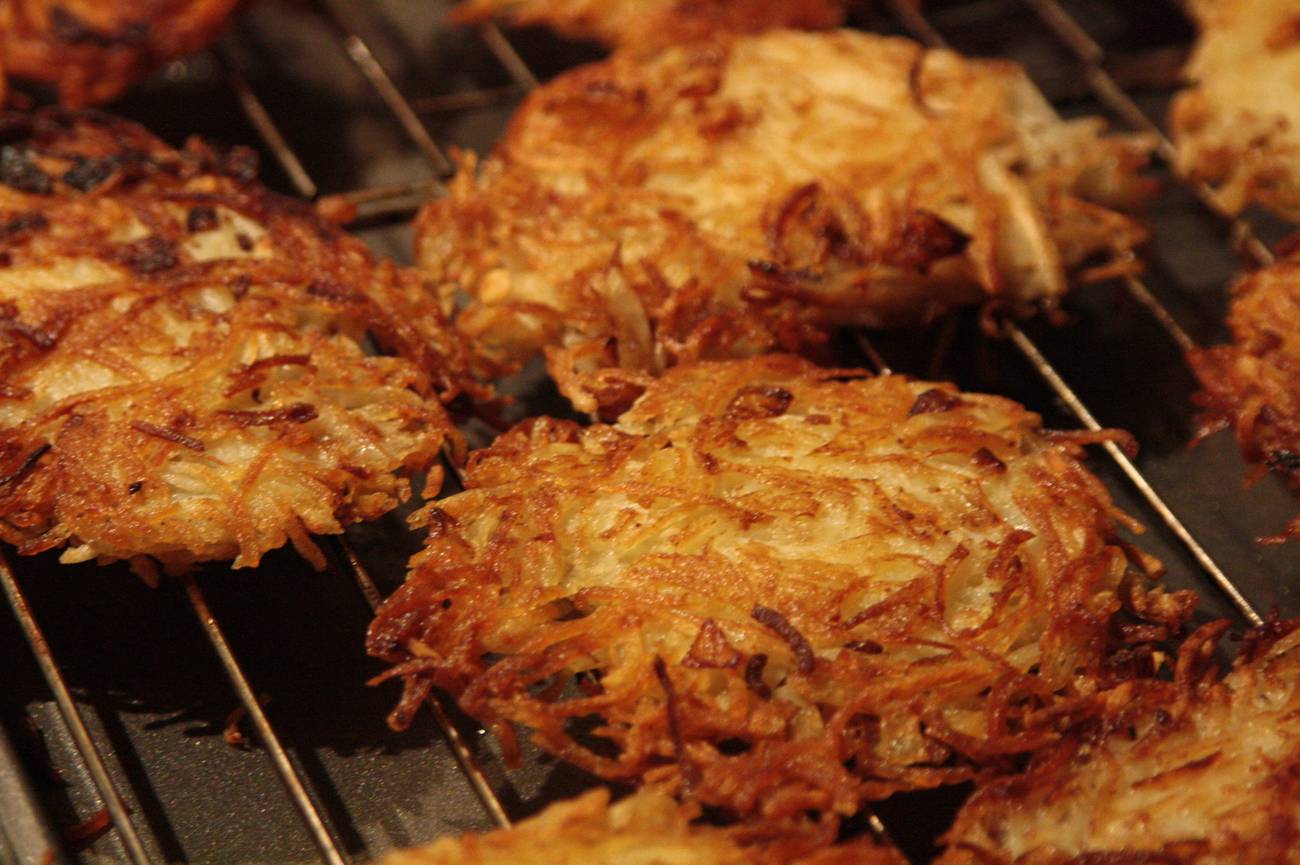Latkes Filled With Meaning
How creating a new Hanukkah tradition helped me rediscover a connection to Judaism




I didn’t eat latkes for Hanukkah when I was growing up. My family didn’t celebrate Hanukkah at all.
My ancestors had spent a century covering up our Jewish identity. In Hungary in 1903, my paternal great-grandfather changed our family name from Nichtenhauser (German last names were associated with Jews) to Nador (an ethnic Hungarian name) to blend into the dominant culture. My grandfather later registered our family’s religion as Protestant, around the time my father was born in 1932, because of the rising tide of antisemitism in Hungary; this didn’t fool the Nazis, who still regarded them as Jewish. But the fiction became part of my family’s reality nonetheless.
While many other family members perished, my parents survived the Holocaust. After they settled in Canada, my father continued doing what his family had tried to do, mostly unsuccessfully, for generations: assimilate. So it’s not surprising that for most of my life I denied myself a Jewish identity.
As a child, while I knew my ancestry was Jewish, I told people I was Protestant. This wasn’t exactly a lie. When I was growing up, my family did not follow any religion; we did not to go to church or synagogue. We did celebrate Christmas with my father’s family—with a tree covered in lights and presents wrapped in Santa-themed paper—but in Hungary, it wasn’t unusual for Jews to celebrate Christmas. My father also hid chocolate Easter eggs for my sister and me to find—but Easter for us wasn’t a religious holiday, but more of a scavenger hunt for chocolate.
Still, even if it wasn’t entirely incorrect when I said I was Protestant, it struck me that I had a made-up name and someone else’s religion. A sense of alienation took root.
My mother held on to her Jewish identity more than my father did—she fasted on Yom Kippur—and her parents remained observant. Occasionally, even though we didn’t celebrate Jewish holidays at home, we celebrated them with my mother’s parents. I remember Passover gatherings where we dipped eggs in salt water and ate matzo “sandwiches” stuffed thick with sweet grated apple and cinnamon. But we never celebrated Hanukkah with my grandparents, or at home. So I never got to eat latkes.
Still, I began to feel some connection to Judaism. As an adult, I stopped saying I was Protestant when someone asked about my faith, because it felt wrong, but I wasn’t yet ready to say I was Jewish, either. “My background is Jewish,” I said instead, a noncommittal nod to my heritage.
After my parents divorced, my mother was no longer tethered to the preferences of my father. She began celebrating Jewish holidays with her observant family. But because I supported my father more than my mother during their separation, and then married a non-Jew, I became estranged from my maternal grandfather, so my husband and I were not invited to holiday dinners.
After our first son was born, my husband and I wanted to instill a connection to Judaism, something my husband’s non-Jewish parents encouraged. When I proudly told my paternal grandmother about taking my toddler to Passover services at the local community center, she was unimpressed. “Haven’t we suffered enough?” she asked. While she still felt Jewish in her heart, she worried about how overt displays of Judaism could harm her family’s safety. Sadly, we never spoke about Judaism beyond her fears.
Despite my grandmother’s reservations, my husband and I didn’t give up on the idea of Jewish celebrations. There were Passover and Rosh Hashanah dinners my maternal cousin began to host. My husband, two sons, and I gratefully accepted invitations. And then, my mother began hosting annual Hanukkah parties. She gathered my two young sons in a tight circle, sang a Hannukah song about “pretty candles glowing in the night,” and set all eight candles ablaze no matter if it was the first night of Hanukkah or the last. And she made latkes, something she had not made for us growing up. They were thick and heavy like hockey pucks. Nonetheless, I didn’t host my own celebrations or make my own latkes, happy to let my mother and cousin take the reins on instilling Jewish culture in my sons.
Then, when my sons entered their teenage years, I spotted a recipe for latkes in the paper, and thought I would give it a whirl. In the beginning, it wasn’t a conscious decision to observe Hanukkah as much as it was a chance to out-latke my mother and try something new. My latkes weren’t a disaster but their texture was limp and they were anemic in color.
I was undeterred. The following year I soaked the grated potato in an ice bath, which made them crispier; the year after that I fried them in a different oil. Last year, probably my 15th year of latke-making, I collected the potato starch that seeped to the bottom of the ice bath from the grated potatoes and put that into the mixture. My latkes were delicate, golden-brown potato nests with a satisfying crunch and tender middle. This year I will do what I do every year, experiment some more. Making the best latkes possible is now a point of pride.
More than pride, actually. It is my claim to authenticity as a Jewish mother: Making excellent latkes feels like a very Jewish-mother thing to do. And, I like how that makes me feel. This little act was the gateway to something more: a sense of Jewish identity.
Latkes are a symbolic way to honor our family’s heritage and remember my mother, who died seven years ago, eight years after my father. They remind me of the sacrifices that both sides of my family made to deliver me to a place of privilege and safety. I can wield a Jewish identity on my own terms in ways they could not. Making excellent latkes has made me feel less like an outsider looking in. We don’t light the menorah or sing songs the way my mother did but this one perfect night of latkes has become our family’s tradition. My now-grown sons say they will carry this tradition forward. This is my gift to them.
Making latkes has led me to reclaim other elements of my Jewish background: Back in September, I decided to make a festive meal for Rosh Hashanah after my husband spotted a spread of recipes in the paper. I made brisket for the very first time. The meat was tender and perfectly seared. I served it with a port-and-star-anise sauce atop a bed of plums. It ranked right up there with my latkes. Another Jewish tradition has begun.
Sue Nador is a freelance writer in Ottawa, Ontario, with an MFA in creative nonfiction from the University of King’s College.